Whats the Likelihood of Getting a Girl to Have a 3sum
Women wishing to delay pregnancy for afterward or forbid information technology from ever happening commonly put all of their bets on the effectiveness of their called nascence control method.
Though successful at their mission, they are not e'er foolproof. Learning about how a adult female'south chances of getting significant while on nascence control vary depending on the failure rates of common methods is key to making educated decisions about ane's reproductive future.
Continue reading to detect how likely is it to get meaning on birth control, including birth control pills and patches, vaginal rings, IUD and implants, among other forms of contraception.
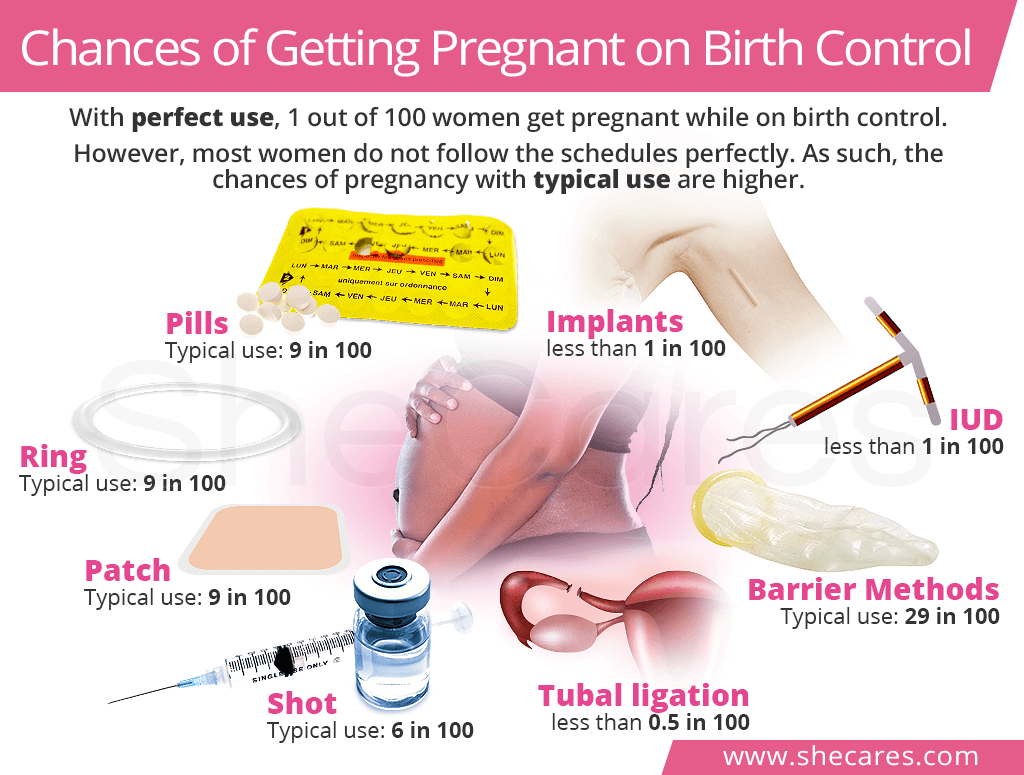

Birth control pills are one of the most popular forms of contraception. They come in two types: combination pills (containing progesterone and estrogen) and progestin-only pills (containing merely progesterone). Because of their popularity, there are numerous brands on the market, such as Sprintec®, Alesse®, or Lutera®.
Consistent use lowers the chances of getting pregnant on nascency command pill down to one%, which means 1 in every 100 women is getting pregnant on while on the pill every yr. However, considering most women occasionally forget or miss their dose, the realistic odds of pregnancy are higher, about 9 in 100 (9%).

Nativity control patches contain estrogen and progesterone, which are absorbed through the skin, where they have to exist applied on a weekly basis. The most common birth control patch brands include Xulane® and Ortho Evra®.
With perfect utilize, a birth control patch is an effective contraception method (99%). As such, the chances of getting pregnant on the patch are most i%. Certain factors, such as obesity or current medications, might decrease their effectiveness, while increasing the odds of pregnancy to 9%.
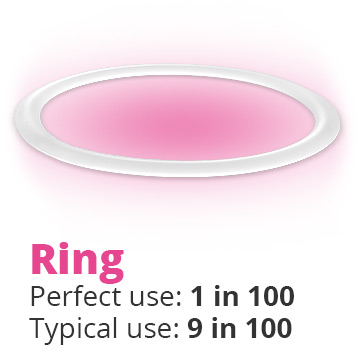
Vaginal rings are self-placed in the vagina for three or four weeks, depending on whether a adult female wants to experience periods. The most common brands of vaginal rings include NuvaRing® or Annovera™.
When used every bit instructed, a adult female's chances of getting significant on a vaginal ring are one%. Its effectiveness can exist compromised if the ring is non placed in the vagina in a timely way or if a adult female is taking certain medications that interfere with its mechanism of action. As such, the odds of pregnancy increase to 9%.
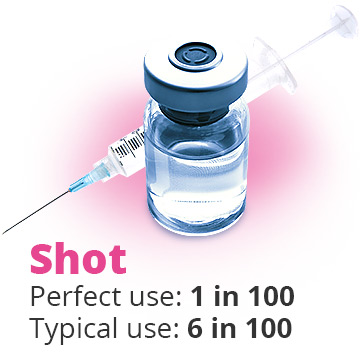
Nascency control shots are administered every three months in a medical facility. The only bachelor brand in the United states of america is Depo-Provera®, commonly referred to as the Depo shot or DMPA. It is also used in the treatment of endometriosis.
The chances of getting significant on Depo shot or other brands of nascence control shots are 1% if a adult female receives the shot every 12 weeks. Delaying a timely administration increases the odds of getting pregnant to 6%, which means 6 in 100 women practice go pregnant on the nativity control shot.

Nascence command implants are small, rod-like devices that are placed in the arm for upwards to 5 years. The brands that offer birth control implants are Implanon® and Nexplanon®.
Birth control implants are considered 1 of the most effective contraceptive methods. Its placement does not require subsequent administrations for several years, which eliminates the risk of forgetting and other human being errors. Consequently, the chances of getting pregnant on the implant are less than i in 100 women (ane%).
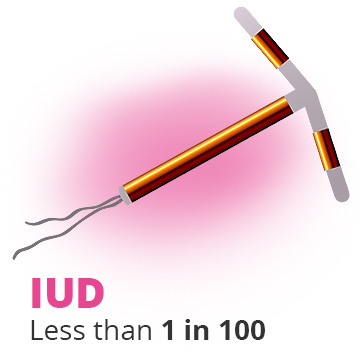
IUD is a T-shaped device placed in the uterus. There are two types of IUDs: copper, such as ParaGard®, or hormonal, like Mirena®. Depending on the brand, they provide protection for 3 to 12 years.
An IUD is another highly effective birth command method. Alike birth control implants, once an IUD is placed, they offering continuous contraception without the need for maintenance. Every bit such, the chances of pregnancy with IUD is less than ane%. When used equally emergency contraception, a copper IUD is 99.ix% effective.
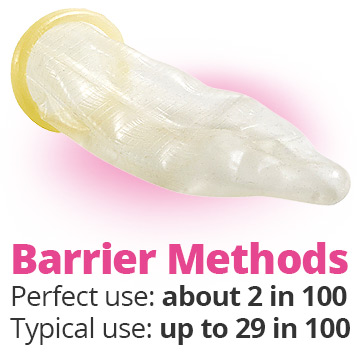
Barrier methods of contraception piece of work by preventing the sperm from reaching the egg. They come in a variety of forms, including condoms, internal condoms, diaphragms, cervical caps, and spermicidal foams, gels, and sponges.
With perfect use, barrier methods can be up to 98% constructive, leaving most a ii% gamble of conceiving. However, the realistic odds of pregnancy when using barrier methods of birth command are much higher because they have to exist used with every intercourse, thus increasing the risk of failure:
-
Male person condom: 15 out of 100 women (fifteen%)
-
Internal rubber: 21 out of 100 women (21%)
-
Diaphragm: 12 out of 100 women (12%)
-
Cervical cap: 29 out of 100 women (29%)
-
Spermicides: 28 out of 100 (28%)

Tubal ligation, colloquially referred to as "having one's tubes tied," is a surgical procedure to cake or close the fallopian tubes so that the sperm cannot reach the egg for fertilization.
Most are permanent, resulting in less than a 0.v% chance of getting pregnant later tubal ligation. Even so, some women might undergo a tubal ligation reversal to achieve pregnancy or relieve post-procedure side effects.
Contraception is of nifty help when pregnancy is not desired at all or is meant to exist delayed for the future. Popular claims virtually their alleged effectiveness often make women wonder what their chances of getting significant on nascence control are. The answer to these doubts are ii-factorial: it depends on the type of contraceptive method used and how diligently a woman adheres to its recommended usage. Perfect use puts women at a 1% risk of pregnancy while on birth control. Still, most women do not adhere to the schedule perfectly, thus lowering their effectiveness and increasing the odds of conception. As such, typical utilize results in higher pregnancy rates, ranging from 6 – nine in 100 with pills, rings, patches, and shots to up to 29 in 100 with barrier methods of nascence control, like condoms or diaphragms.
- American College of Obstetricians and Gynecologists. (2018). Barrier Methods of Nativity Control. Retrieved Jan 24, 2019 from https://www.acog.org/~/media/For%20Patients/faq022.pdf?dmc=1&ts=20120604T2122545757
- Contraception. (2011). Contraceptive failure in the United states. Retrieved January 24, 2019 from https://www.ncbi.nlm.nih.gov/pubmed/21477680
- Eunice Kennedy Shriver National Institute of Child Health and Human Development. (2017). What are the different types of contraception? Retrieved January 24, 2019 from https://www.nichd.nih.gov/health/topics/contraception/conditioninfo/types
- Food and Drug Administration. (2018). Nativity Control. Retrieved January 24, 2019 from https://www.fda.gov/forconsumers/byaudience/forwomen/freepublications/ucm313215.htm
- Office on Women's Wellness. (2017). Nascency control methods. Retrieved January 24, 2019 from https://www.womenshealth.gov/a-z-topics/birth-control-methods
- Planned Parenthood. (n.d.). Birth Control. Retrieved Jan 24, 2019 from https://www.plannedparenthood.org/acquire/nascence-control
- Washington Academy of St. Louis. (2015). IUD, implant contraception effective beyond FDA-approved utilise. Retrieved January 24, 2019 from https://source.wustl.edu/2015/02/iud-implant-contraception-constructive-beyond-fdaapproved-use/
More on How Conception Works
Source: https://www.shecares.com/pregnancy/chances-of-getting-pregnant-on-birth-control
0 Response to "Whats the Likelihood of Getting a Girl to Have a 3sum"
Post a Comment